#modern carapace
Text
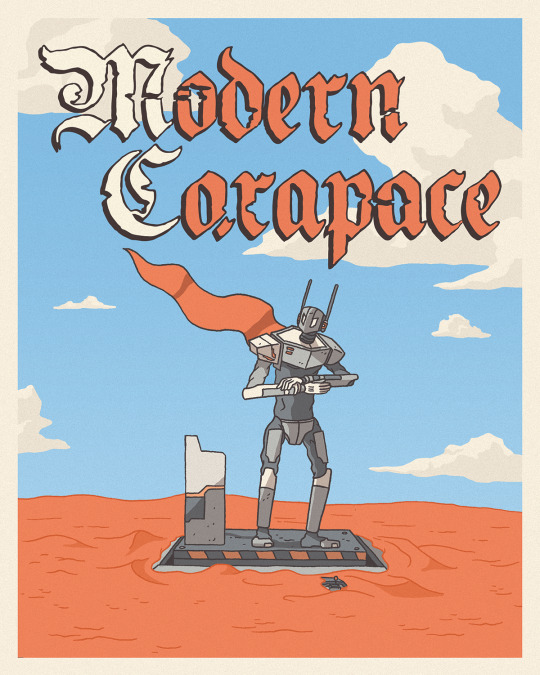
If you like kaiju and mecha, read the first book in my MODERN CARAPACE series: O Bounty Of Thy Ribs. This 72-page graphic novel is the story of Esther, a park ranger who pilots the Tarantula Hawk, a prototype mecha, and uses it to protect desert-dwelling insectoid kaiju from poachers.
#jakud#artists on tumblr#comics#kaiju#modern carapace#kaiju art#mecha art#comic book#graphic novel#comics on tumblr#digital comic
5K notes
·
View notes
Text
Some headcanons regarding TMNT physiology
Over the years, I have come up with some headcanons regarding how I believe the Ninja Turtles' bodies work. I thought that perhaps it might be nice to finally share them with all of you.
These don't apply to all the iterations, of course, but they are pretty well universal in my mind, and I tend to incorporate most of them into my fanfics.
The Turtles (like leatherback sea turtles, echidnas, and some dinosaurs) are mesotherms, meaning they are neither warm nor cold blooded. They are, instead, in a middle-ground: they internally generate heat, but not to a constant temperature. In the Turtles' case, they will shiver when cold, and their bodies will not shut down right away when the temperature dips too low, though they may lose some energy and find it hard to concentrate.
Unlike many other modern reptiles and amphibians, who have a three-chambered heart, the Turtles have four-chambered hearts (like mammals and dinosaurs) that are larger and stronger than average human hearts and located at the center of their chests.
While the average human blood capacity is around five liters, the Turtles have about seven. Much of the blood flows under the shell -- a remnant of their lives as ordinary turtles, whose own blood does so in order to warm them when they bask. This means that the Turtles could lose close to three liters of blood before dying, while a human would only be able to lose two.
Their blood is also highly efficient at clotting, but that also means that storing blood for transfusions is difficult, and so must be directly transfused from one turtle to another in emergency situations.
Owing to their extensive circulatory system, they also have a larger lung capacity than humans and more oxygen-rich blood, and so are able to hold their breath for extended periods of time without adverse effects. Other than this, the Turtles' respiratory system is very much like humans', utilizing a diaphragm to inflate and deflate their lungs.
Like regular turtles, they do not have ribs, but rather their carapaces and plastrons serve that purpose, and they have muscles under their shells that keep their internal organs right where they belong.
Also like regular turtles, their spines curve along the insides of their shells. A direct hit on the center of their shells, then, could cause damage to their spinal column and nervous system, but fortunately their vertebral shields offer a fair amount of protection, so it would take quite an impact.
The Turtles are highly resistant to most infections and diseases, which increases their immunological responses. They do not get sick easily, and they recover quickly.
While their scales are not apparent, they are integrated into their skin, making it tougher than human skin. It takes a very hard hit to raise a bruise, and it is difficult to cut through without a very sharp or pointed blade.
Their bones are similar to humans, but are more resistant to breaking. They also heal quicker and stronger if they are broken.
Their muscles are also very close to human-like, but they are stronger than an average human due to compensating for the extra weight they carry in their shells. Because of this, their ligaments and tendons are also tougher, and it is difficult for them to have a joint dislocated.
Their sense of smell is more acute than humans, but not to an extreme degree. They are also not as bothered by foul smells (though this has more to do with living in a sewer than their physiology).
Their eyes are a bit tougher and more resistant to damage than human eyes due to a protective membrane that covers them. They see a bit better than humans in dark places and underwater.
Their hearing is somewhat more attuned to lower frequencies than human hearing, and is not dependent on external ears but rater an internal auditory system (making direct damage to their hearing unlikely).
They are capable of being knocked unconscious, but it takes a significant impact. Permanent or lingering damage to their brains is unlikely due to their structure, and so they also do not tend to suffer the same side-effects that humans would in the same circumstances (nausea, memory loss, etc.).
Although their nutritional needs are similar to humans, they do not need to eat every day, and in fact can get by quite well without food for a week if necessary (though they won't enjoy it). When food is readily available, however, they will eat as much as possible to store up energy. Their metabolism does not slow down when they do not eat, so overexerting themselves when they haven't had any food for a while can burn them out suddenly.
Their sleep schedules are much like most diurnal animals, though they are able to stay awake for extended periods of time and can get by on little sleep, if necessary. There have been times when they have been awake for days on end, getting by on short one hour naps here and there. In general, though, they like to have a regular sleep/wake cycle.
Like other reptiles, the Turtles never stop growing throughout their lifetimes; however their growth is slow, topping off at about 1-2 inches every five years.
Does anyone have anything they would like to add to the list? I actually had fun compiling it!
#tmnt#teenage mutant ninja turtles#ninja turtles#fanfic#fanfic reference#rise of the teenage mutant ninja turtles trailer#rottmnt#tmnt 2003#tmnt 2012#tmnt 2007#tmnt bayverse#tmnt vs batman#tmnt comics#tmnt mutant mayhem#tmnt mm#whump#whump reference#tmnt 1987#tottmnt#tales of the tmnt
1K notes
·
View notes
Text

The tuzoiids were an enigmatic group of Cambrian invertebrates known mostly just from their spiny bivalved carapaces. Although hundreds of fossils of these arthropods were discovered over the last century or so, only vague fragments of the rest of their bodies have been found even in sites usually known for preserving soft tissue impressions.
…Until late 2022, when several new specimens from the Canadian Burgess Shale deposits (~508 million years ago) were described showing tuzoiid anatomy in exceptional detail, finally giving us an idea of what they looked like and where they fit into the early arthropod evolutionary tree.
Tuzoiids like Tuzoia burgessensis here would have grown up to about 23cm long (~9"). They had large eyes on short stalks, a pair of simple antennae, a horizontal fluke-like tail fan, and twelve pairs of appendages along their body – with the front two pairs at the head end being significantly spinier, and most (or all) of these limbs also bearing paddle-like exopods.
The large carapace enclosed most of the body, and was ornamented with protective spines and a net-like surface pattern that probably increased the strength of the relatively thin chitinous structure.
Together all these anatomical features now indicate that tuzoiids were early mandibulates (part of the lineage including modern myriapods, crustaceans, and insects), and were probably very closely related to the hymenocarines.
Tuzoiids seem to have been active swimmers that probably cruised around just above the seafloor, with their stout legs suggesting they could also walk around if they flexed their valves open. The arrangement of their spiny front limbs wasn't suited to grabbing at fast-swimming prey, but instead may have been used to capture slower seafloor animals or to scavenge from carcasses.
———
NixIllustration.com | Tumblr | Twitter | Patreon
#science illustration#paleontology#paleoart#palaeoblr#tuzoia#tuzoiidae#hymenocarina#mandibulata#arthropod#invertebrate#cambrian explosion#art#MYSTERY TACO
2K notes
·
View notes
Text
CASUAL part 2
see part one here.
modern!incel!asshole! eddie x fem!reader

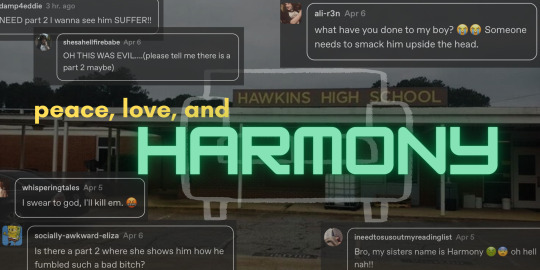

It’s 7 in the morning. Eddie is seen doom-pacing in the halls of Hawkins High.
a/n: i promised y’all part 2 so here ya go. let’s make him pay. 💋 also shout out to @love-anonymous-writer for bringing this universe to life. a little angst here and there is good for the soul <3
who got the last laugh?
[WC: 1.1k words]
“Please respond…please respond…please respond…”
The soles of Eddie’s shoes slam against the tiles of Hawkins High as he rushes to your locker. Meanwhile his entire soul has left his body.
You didn’t answer any of his phone calls. All the texts he sent you were left on read. Having been so accustomed to your instant replies, Eddie essentially catapulted himself into a full-blown panic last night when he saw the ominous text you sent him...and the nothingness from you that followed soon after.
The crickets of Forrest Hills that taunted his eardrums later that night served as a vengeful metaphor of the brick wall you built between you and him. The girl who once gave him everything has now started giving him nothing. You’re nowhere, but everywhere. It’s like you’ve become a ghost.
When he sees you, color drains from Eddie’s guilty face. You look so beautiful today, hair curled down to the small of your back, a nice simple dress and some slippers, with makeup ever so gracefully applied. A class act, even when plagued with the utmost disrespect.
“Hi," he says to you as he approaches.
“Hi.”
As far as Munson knows, he no longer exists to you. He's a shadow now, a carapace of a boy you used to love 'cuz now — after hearing what you heard in his trailer — you know he's not the same boy that made you feel all the butterflies. That boy is long gone. You even start to wonder if that version of Eddie even existed.
“C-can we talk, please?” he requests.
“What’s to talk about?” you challenge him, stoically. “Don’t wanna annoy you with my rambling.”
“You never annoy me…” he attempts as you mindlessly comb through your locker for your homeroom notebook.
“Mm.”
You were casual about it. Too casual about it.
“You… uh…” he clears his throat. “You made me cookies yesterday?”
“Yeah,” you shrug. “I was at your door for quite a while so you must’ve been busy. Cookies were taken care of though.”
“I see…” Eddie mutters as the pieces all start coming together.
He thinks about how he always leaves his windows cracked open. His uncle would whoop his ass if he hot-boxed the trailer again, so it became a habit. But the trailer park is small, and on certain afternoon, if someone from a nearby unit had dropped a pin, Eddie would hear it. Suddenly, fear arises in him.
Surely, you didn't hear everything he and The Boys™️ said. He had his headphones on and he couldn't have possibly been that loud, could he? Unless technology failed him again.
The warning bell sounds throughout the halls and you excuse yourself from the narrative. Eddie tags after you like a lost puppy, nearly tripping on his shoelaces along the way.
"W-wait!"
The first class of the morning is homeroom. A class you unfortunately shared with Eddie, Grant, and Harmony.
You didn't want to see any of their faces. Eddie's face would serve as a reminder of how fake and construed the fucker is. Grant's would remind you of how insignificant you were to the guys (despite how welcomed they made you feel at the start). And Harmony. Harmony's beautiful face — with a body far too developed for a girl in her grade to match — would only remind you of the fact that the girl didn't inherently do anything to you... other than be beautiful and get caught in the crossfire of horny, greasy teenage boys.
It’s a fucking mess.
You swallow hard and keep your chin up regardless. Because what other choice do you have? You either feign your confidence or let irrelevant boys crush it.
You continue strutting over to your seat as Eddie trails behind at a measurable distance. Along the way, you inevitably run into the Junior Queen of Hawkins High herself, Harmony Heathers.
Harmony issues you a sweet smile. You smile back at her in return. And you didn't even need to turn your back to know that Eddie most likely did a double-take when sliding past her.
The late bell rings, indicating the start of class.
“Okay,” your homeroom teacher Mrs. Helleck exhales as she clasps her hands together. “Good morning everybody. For Red Ribbon Week this week, we’re gonna be doing a group project. Worth 20-percent of your grade.”
The class erupts in agonistic groans while Mrs. Helleck attempts to calm them down. You feel Eddie’s gaze burn into you, indicative to the fact that he was looking forward to using you again like he always seems to do. This time around it would be for a grade instead of a two-pump fuck. But you had something else in mind.
“You will be doing a presentation,” Helleck continues. “With a partner of your choice. Your job is to create a slogan along with a list of reasons why you should stay away from drugs.”
“Drugs Instead of Hugs,” Grant mutters to Eddie.
The general vicinity collectively praises his lukewarm wannabe 4-Chan edged joke.
You roll your eyes while your poor homeroom teacher tries to proceed with her instructions, despite the immature snickers.
“You will be presenting with your partner on Friday. Do not wait until last minute to do this assignment please. Deadlines catch up to you fast.”
Mrs. Helleck makes her way over to you.
Like Dungeons and Dragons, everyone in the class is assigned a “classroom role”. You’re the leader of the pack, the ‘foreman’, to which you never understood because up until today you never had the confidence to call the shots. The alphabet has never been on your side anyways.
“Now dear,” your teacher smiles down at you. “Since your last name starts with an A, you get first choice. Who would you like to work with?”
Eddie’s gaze is extra fixated on you now. It gives you a greater deal of satisfaction than tossing those cookies ever did. It was you who had the reigns now, instead of those woman-patronizing incels.
You start to smile connivingly, to which the guys start to gulp over. You can tell they’re putting two and two together, their two brain cells collectively working over time to discover that you had a delicious upper-cut up your sleeve.
It’s the very least they can do. If they wanted to taint your name to smithereens in your absence, you’re sure as hell going to give them something else to lose their minds about in Math 3.
And when all eyes are fixated on you, you tilt your chin up to project your voice. You want to make sure everyone, especially Grant and Eddie, hear you loud and clear when you sinisterly announce,
“I pick Harmony.”
tag list: @damp4eddie @eddiesguitarskills @babygirl229 @love-anonymous-writer @ziggeddie @socially-awkward-eliza @shesahellfirebabe @ali-r3n @yourdailymemedelivery @mincloud @jupitersnights @ineedtosusoutmyreadinglist @whisperingtales @fearlessreid @emma-munson
divider by: @benkeibear
#eddie munson#eddie munson angst#eddie munson one shot#eddie munson mini series#requests#maddy’s requests 🍸#part 2#eddie x reader#eddie munson x reader#eddie munson x fem!reader#eddie munson x you
217 notes
·
View notes
Text
Bestiaryposting Results: Shonweak
This is an unusual one in terms of whether people have preconceptions on what it looks like. On one hand, the medieval interpretation of this animal is widespread and generally known, at least in comparison to other bestiary material -- shows up in modern fantasy and everything -- so it's possible that people familiar with medieval stuff recognized it on sight and had to work against those preconceptions. On the other hand, the medieval interpretation is pretty much completely divorced from reality, so anyone coming at it from a background of Actually Knowing Animals rather than one of Knowing Medieval Nonsense is likely going to be baffled.
Anyway, as usual, if you're confused by what I'm talking about, please refer to https://maniculum.tumblr.com/bestiaryposting. And you can find the entry that artists are working from here:
Art below the cut, roughly chronological, &c.
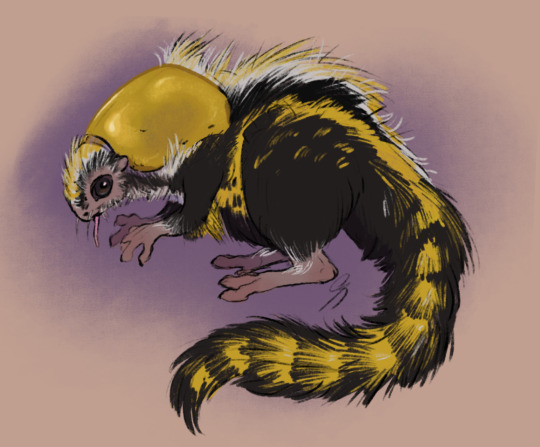
@silverhart-makes-art (link here) says that they wanted to draw a Weird Little Creature, and... mission accomplished, that creature sure can Weird and Little. I kind of love it; it's got that vibe that makes something simultaneously cute and kind of unsettling. The linked post goes into some detail about design decisions and the real-world animals they used for inspiration. Something I think is particularly clever is how they not only incorporated the carapace from the beetle they were inspired by, but they also made the profile of the head fit with that, so that it also looks kind of beetle-like despite being obviously mammalian.
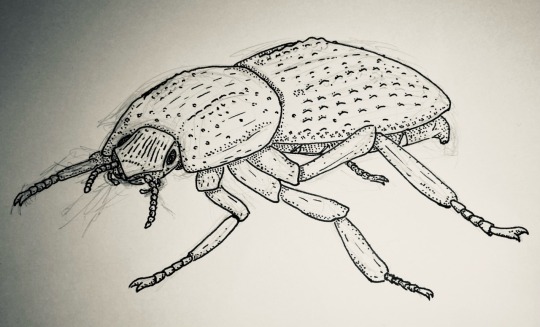
@cheapsweets (link to post here) also had Beetle Thoughts and decided to just run with them, creating an impressively-realistic-looking drawing of a beetle. (I think I'm just a sucker for black-and-white naturalist-style art, because lately I keep looking at CheapSweets's work and going "ooh, look at the stippling and everything". Plus I'm perennially impressed that they do this with a fountain pen.) There's some detailed discussion in the linked post about what specific beetles this design takes inspiration from, as well as how they envision this animal functioning in general, and that's really interesting, so I recommend checking it out. (Did you know there was a beetle known as the "diabolical ironclad beetle"? Delightful.) Additionally, they note that we should imagine bright warning colors, but they didn't have time to add them. Also, thank you CheapSweets for providing alt text.

@sweetlyfez (link to post here) also notes that this critter would have bright warning colors if she'd had time to color it. Apparently this design is inspired by poison-type Pokemon, which I can definitely see: that's a credible Pokemon design. It's all gloopy for putting out fires. I find it interesting that there's a degree of consensus on this entry being interpreted in this way -- replies on the original post expressed that That Is A Pokemon, and seemingly SweetlyFez agrees. I like the side-eye it's giving, too. (And thank you for including alt text.)
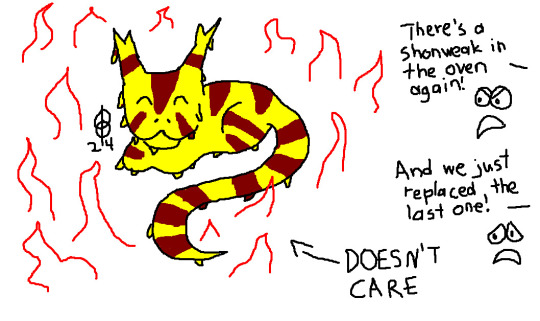
@pomrania (link to post here) was the one to label this a Pokemon in the replies, and we can see that they've run with that a bit, as this is also a credible Pokemon design. It's a little bit cat, a little bit dragon, and a little bit liquid so it can put out fire. I like that it looks so pleased with itself while causing problems.
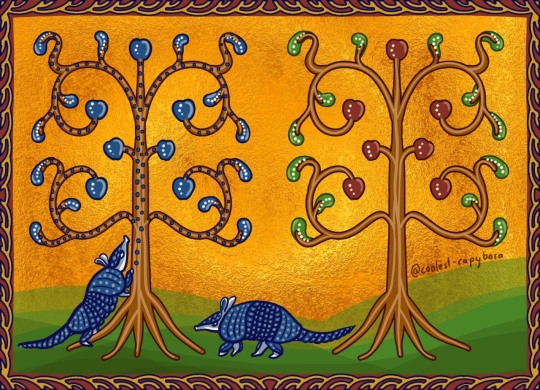
@coolest-capybara (link to post here) has decided that the Shonweak is an armadillo. This illustration shows some very nice Stylized Trees, I must say, and I particularly like the visual effect showing that the Shonweaks are poisoning the one on the left. (Coolest-Capybara also makes note of the Pokemon thing.) For an explanation of why they are armadillos, please see the linked post.

@strixcattus (link to post here) has drawn a very charming little creature. I love the puffed-up cheeks & throat sac, and the effect that has on its facial expression. If you check out the linked post for a proper description of this beast, you'll find it's quite interesting -- I particularly like the idea that it spits poison by filling its throat sac with water and then allowing its natural poison to seep into that water. I think that's pretty clever.
Now, to the Aberdeen Bestiary, where the illustrator has done a Scene that takes up most of the page:

That's a heck of a thing, right? I really like it, to be honest. We've got the cool Stylized Tree with critters wrapping around the branches, we've got the ones in the fire doing kind of a flame-like pose, and of course we have a dead guy at the bottom. The last of these just strikes me as funny for some reason.
Anyway, as I think multiple people guessed, this is the salamander.
No, the illustrator had apparently never seen one, so they've drawn snakes instead, probably because of the association with poison.
Anyway, I was surprised to learn (just now actually) that salamanders really are quite poisonous. I have no idea whether they can poison food and water in the way that the author describes -- that seems a bit extreme -- but I don't think I know enough to rule it out.
The fire thing... well, that's definitely not the case. I'm not really sure where that came from. I've heard the explanation that people in the past would occasionally see salamanders crawling out of fires, and thus form the idea that they were fireproof, unaware of the fact that the salamanders were just hiding in their firewood and are fleeing the fire as a result of being Definitely Not Fireproof. I don't know how credible that is, though.
This fire association may have been amplified by... well, look at this:
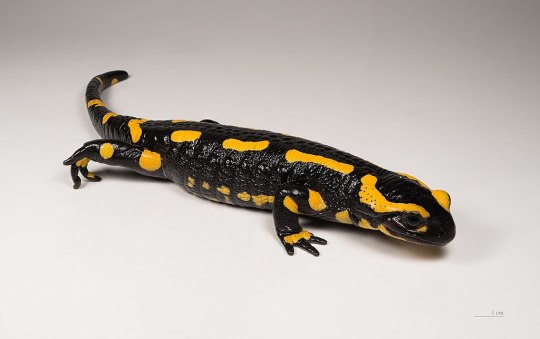
That's Salamandra salamandra, aka the fire salamander. It's pretty common and widespread in Europe, and is also among the largest salamanders on the continent, so it's reasonable to think this is the one that pre-modern Europeans would have in mind. And you know, that coloring definitely gives the impression of "this is a Fire Guy". If one were to see this salamander crawling out of a fire (worth noting that the Wikipedia article does say they like to hide under fallen wood, so maybe that idea tracks), and knew nothing about zoology, you could see how they might think "yes, that looks like something that was supposed to be in there."
55 notes
·
View notes
Text
Out of Context Amber Skies Lore:
Due to the commonality of replacing limbs, there are entire martial arts that have been developed by and for people with crutches.
There is a civilization that builds trade ships out of the discarded carapaces of enormous crustaceans.
Owing to a civil war roughly 310 years before the setting, there are two ethnically Atlantean confederacies. Both consider themselves the true heirs to the empire.
Modern computer technology is based on extraordinarily durable forms of yttrium crystal data storage formats discovered via archeology.
404 notes
·
View notes
Text
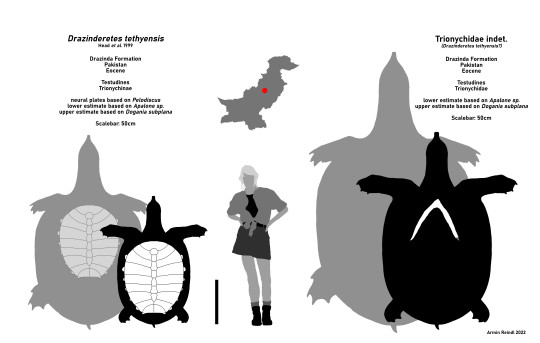
Back to older art. These are giant softshell turtles found in the Eocene Drazinda Formation of Pakistan. On the left is Drazinderetes (Greek for Drazinda Rower), known from a bony carapace 0.8 meters long. On the right, an indetermined softshell turtle that may or may not belong to the same species, but is only known from a plastron element. This might correspond to a bony shell 1.2 meters long. As you can see there are some big difference between the lower estimate and the upper estimate, which has a lot of free space. This is because in different softshell turtles there's difference ratios between the bony and the soft shell parts. The lower estimate is based on Apalone softshell turtles, which have only 20% cartilage on the shell, while the upper is based on the Malayan softshell which has up to 45% cartilage in addition to the bone.
First image Apalone ferox (Florida softshell) by Johnskate17 on Wikimedia
Second image Dogania subplana (Malayan softshell) by Wibowo Djatmiko on Wikimedia

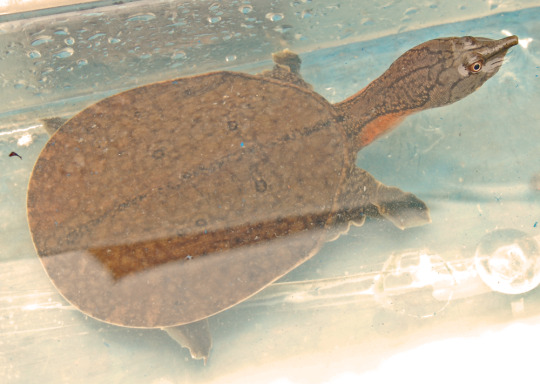
Drazinderetes lived during the Eocene in what is now Pakistan in the Drazinda Formation. This is interesting as this formation preserves a marine environment, meaning that in the absence of evidence that the fossils were washed out at sea, Drazinderetes might have been a marine animal. This would match its enormous size, as most giant turtle species have been marine (not counting those of Miocene South America). Although this would make it the first known fully marine softshell until evidence of the contrary is found, modern softshells are known to occasionally enter saltwater. Drazinderetes shared its environment with crocodiles similar to Asiatosuchus, early manatee relatives in the form of Protosiren and primitive whales related to Basilosaurus. The following reconstructions have both been made by @knuppitalism-with-ue during his paleoart streams.
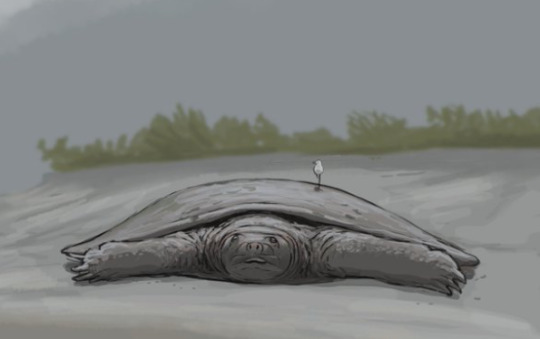
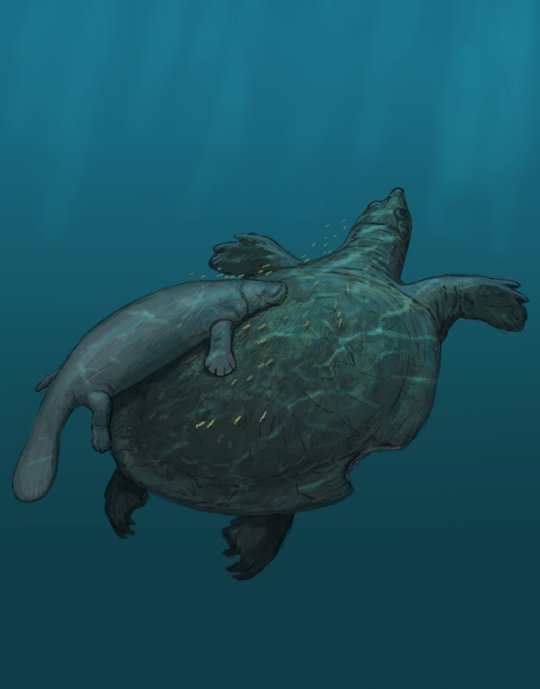
#drazinderetes#softshell turtle#eocene#palaeoblr#paleontology#turtle#drazinda formation#pakistan#skeletal reconstruction#skeletal#size comparison#palaeontology#big fucking turtle
344 notes
·
View notes
Note
Do you know any ancient sea creatures that you really like, like any specific trilobites or dickinsonia or the famous animalocaris
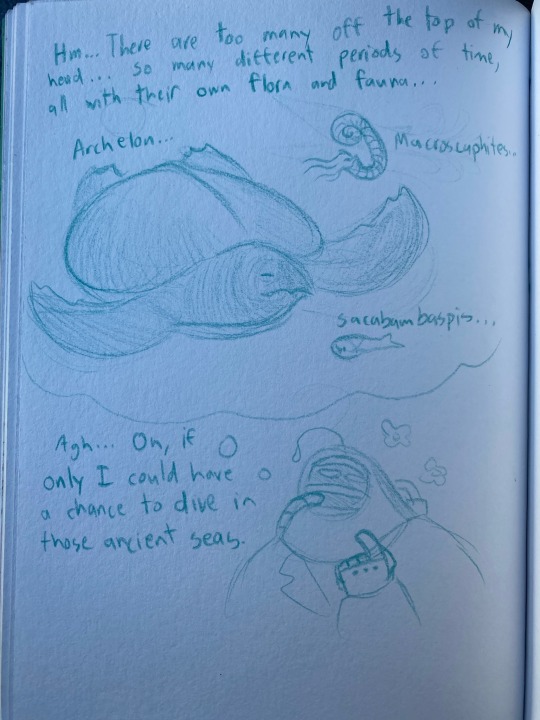
This world has lived for billions of years, and through out the ages the ocean was filled to the brim with a whole plethora of sea creatures. To the Cambrian Explosion to the age of the dinosaurs, countless species “rules” the oceans. Forgive my sketches here, they could never encapsulate the true glory and scale of these creatures.
One creature that may seem familiar is the Macroscaphite, belonging to the extinct subclass of Cephalopods named Ammonoidea. You may know them better as the common name of “ammonite”. One may be familiar with the modern day Nautilus and assume that it is a long lasting member of this subclass due to their striking similarities, but ammonite were actually closer related to the subclass Coleoidea. This is the group of shell-less cephalopods such as octopi and squid.
Back in the day many ammonites had rather absurd shells, not just the polite little spiral you may sea in many textbooks. Some where cones spiraling up in the most ridiculous manner, some possessed dangerous ridges and spikes, others… well, as you can see with Macroscaphite… I cannot even begin to describe what this shape reminds me of. It is somewhere between a trombone, a paper clip, and a slide whistle. It is as if they all came together and had an abyssal child together, how beautiful.
Sacabambaspis is a mouthful of a name, which is funny to conchsider when you remember that it is a jawless genus of fish. “But Mary,” you say, “how can this fish eat without a jaw?” For this you can look to living examples such as lampreys and hagfish. These specimen can latch onto larger animals like a suction cup. Adult lampreys are parasitic in nature, scraping a “tongue” against their host for a good mouthful of meat. This does not kill the host, that would be bad for the parasite, but it is rather uncomfortable to say the least. I’m saying this from experience. Not enough is known about Sacabambaspis as a whole to say if it was a parasite itself. It is likely that it employed a similar sucking motion to collect food.
As for the Archelon… What a magnificent creature it is, no? The largest documented turtle to swim the seas. Approximately 15ft from head to tail, this reptile would’ve been taller than I am! Can you imagine that? Someone larger than me? There are the boss cogs, yes, but outside of that bunch there aren’t many who rival me in size. Much like the living leatherback sea turtle, Archelon would’ve had a leathery shell, or carapace, unlike other hard shelled turtles. Who knows what prehistoric jellyfish or squid this beast may have consumed. It is hard to imagine such a large fortress of an animal to be contested in its oceans, but during its life the Archelon would’ve shared its waters with large marine reptiles such as the mosasaur.
[The Deep Diver sighs, shutting her notebook and tucking it into a comically small pocket on her suit.]
If only I could have the chance to meet these creatures, even if it is only for a moment… oh well. No reason to dwell in the past, to have suck silly dreams swimming around in my helmet.
34 notes
·
View notes
Note
Do you have any info on computers or technology in general?
tech-based objects are unique in that they have only begun to evolve much more recently than most other species. they have no known habitat in the wild and are one of the very few objects that can be man (or object) made.
they are a fair bit more "domesticated" than other object species and due to only recently beginning to appear, they are rare and not well studied. their biological workings are a mystery, but unlike other object species, they lack most vital organs. they don't have a heart or lungs, and in place of bones and nerves possess an endoskeleton of what seem to be flexible metal and wires. though they are very robotic in nature at first glance, a few studies have revealed that their internals are naturally occurring components that have simply adapted to mimic inorganic material.
they survive off of electricity, and instead of sleeping they charge themselves up or use batteries if they're an old world species. like any other object, they are able to process normal food, though most prefer not to. their limbs are covered by a tough, metallic carapace, and manmades might have robotic limbs instead.
old world vs. new world species
with how fast technology evolves in the modern world, we have separated the mechanica class into two: old world and new world species. old world objects, as the name suggests, are older, "archaic" technology by human standards. these are much bulkier and more resilient than their new world counterparts. they also usually require batteries, though this isn't a requirement. you will find species like handheld radios, remotes, electronic toys, and crts in this category.
new world objects are modern tech. this is where you find your phones, laptops, gaming systems, and flatscreens. they are usually able to plug into a charging station or outlet to regain energy, but again this isn't a requirement. they are more fragile than old world species.
15 notes
·
View notes
Photo

Work in progress sketch for Doedicurus clavicaudatus, an extinct member of the glyptodont subfamily from what would eventually become northeastern Patagonia. Glyptodonts are extinct giant-sized relatives to modern Armadillos, Doedicurus being one of the largest members of the family, weighing in at a hefty 3,100 pounds.Like their modern day relatives they possessed a dome-like carapace made of tightly packed osteoderms which provided protection from the large predators in it's environment, such as smilodons and short-face bears.
Doedicurus possessed some decidedly heavier weaponry than most of it's relatives in the form of a large spike covered tail club, itself reaching lengths of over 3 feet in length and likely being able to hit at speeds of up to 25 miles per hour.
D. clavicaudatus likely grazed the planes of Patagonia from just over 2 million years ago until it went extinct around 8,000 to 7,000 years ago. There are many hypotheses as to why megafauna like Doedicurus went extinct around this time, with the causes likely being due to any number of factors, such as climate change and the migration of human populations and the overhunting of such animals.
There is evidence to show that early human settlers of South America did live alongside and hunt Doedicurus, but it is not definite that this was the sole cause of their extinction.
#workinprogress#wip#Doedicurus#pleistocene#mammal#prehistoric#paleo#paleoart#paleontology#sciart#science#digitalart#digitalillustration#illustration#illustrationart#art#artist#humanartist#armadillo#artistsontumblr
110 notes
·
View notes
Text

Esther Wheatley, park ranger, pilot of the prototype mecha Tarantula Hawk, will fight to protect desert-dwelling insectoid kaiju from poachers in MODERN CARAPACE: O Bounty Of Thy Ribs. A 72-page graphic novel you can read now!
#artists on tumblr#jakud#modern carapace#kaiju#comics#mecha#graphic novel#digital comic#monsters#robots#comics on tumblr#creator owned comics#comic book
192 notes
·
View notes
Text

Panacanthocaris ketmenica* here was a member of an extinct group of crustaceans known as kazacharthrans – close relatives of modern tadpole shrimp known mainly from Central Asia during the mid-to-late Triassic (but with possible German relatives from both the late Triassic and further back in the late Paleozoic).
Fossils of Panacanthocaris have been found in Kazakhstan and northwest China, dating to about 235-221 million years ago. It was fairly big compared to most of its modern cousins, reaching at least 10cm in length (~4"), and had distinctive spines around the edges of its carapace and its telson.
It's not clear if it had eyes – there's a single opening near the front of its carapace that may have housed some, and so I've depicted it here with just one naupliar eye similar to the "third eye" of tadpole shrimp.
It probably had a fairly similar lifestyle to its modern relatives, living in shallow freshwater and temporary pools and opportunistically feeding on everything from algae to smaller aquatic animals.
(* Sometimes also called P. ketmenia. May also be the same thing as Iliella spinosa, but until that paper is officially published the current name still stands.)
———
NixIllustration.com | Tumblr | Patreon
#science illustration#paleontology#paleoart#palaeoblr#panacanthocaris#ilellia#ketmeniidae#kazacharthra#branchiopod#crustacean#arthropod#invertebrate#art#triassic weirdos
248 notes
·
View notes
Text
Excerpts from Dedusmuln’s Academic Essay on The Nature of Paper Cups

The following passages your visual organs are about to witness have been extracted from Dr. Dedusmuln’s postdoctoral analysis on the elusive paper cups that they discovered whilst helping save the planet from King Gibby’s tyranny.
As the original had been transcribed on 115 slabs of polymer, these excerpts were taken from segments deemed most coherent to the common, non-archeological minded hylic as per the doctor’s request, so that all may pleasantly approach the concept of these ancient cups' true potential.
Slab 3
Now that I have introduced your beings to the microcosm of the paper cup, I can imagine one question must be manifesting in your minds: What is paper?
As is the current theory, paper is a texture that once bloomed throughout the planet during the dominion of the one-lifes. They were the larval form of much larger sedentary organisms called trees, which were not too dissimilar to that of our vegetables in that they were vertical and most-likely green in color and/or soul, but vastly different in their manifestation.
A single piece of paper would be crumpled up and buried into the earth, acting as the “egg” for which the stalk of a tree would hatch out of and mutate. Over time its soft flesh would harden into a thick carapace known as “bark,” for which the one-lifes would shred to produce thousands of pieces of paper. Some of these trees were said to be as tall as our cities’ buildings!
The one-lifes molded all kinds of things out of paper, including but not limited to: writing slabs, clothing, wall-clinging memos, medicated water-closet paper for personal use, birds, money, towers, masks, and most importantly cups. It was through these cups that one-lifes were able to intake liquid, their most powerful source of energy, from coolers in order to stay alive as long as their bodies would allow.
Paper cups were also quite remarkable in their dexterity! Whilst most paper would weaken under the moistness of such a liquid’s viscosity, the cup could most easily contain the clear juice without the threat of disintegrating. They were able to withstand crushing grip of a one-life larva, and could even be used to catch a deluge!
Slab 4
As wondrous as these facts are, however, this durability has sadly become a luxury of the past biosphere that cannot be replicated more than once now due to their immense age. Once a paper cup is used now, it’s gone forever.
Most modern era science has classified paper as a “theoretical concept” texture; one that may have existed at some point on this planet before Accretion 0 but can no longer maintain its form on our current biosphere. This prevailing attitude metamorphosed after Dr. Smuldunde’s success in their Greater Toothpick Expedition, however, due to their world-altering discovery of full intact wood textures.
If the carapace of trees were able to survive our dominion of clay, then surely it is not a farfetched theory that paper must have survived too. I had taken it upon myself to prove this theory correct, a seemingly impossible task that proved just as possible as the beheading and explosion of our planet’s demiurge.
Next I shall take the time to describe the anatomy, thermodynamics, and overall usage of the paper cups and water coolers for clay organisms. I will try to make this brief…
Slab 97
...and the essence of life itself flows from its frustum and into our flesh and souls!
Returning to the topic of Pre-Accretion societies, the resilience of these paper cups and their water coolers they harvested from make it most apparent that, like many products, were once also utilized by beings during the Age of Sages before our own Accretion buried them from us. It would be the most logical explanation behind the idea that willpower was overall greater in that era.
To confirm this, I utilized a rare benefit in my knowledge of the sage’s locations to ask them personally to reflect their memories of the past usage of paper cups toward my research.
Unfortunately, the only sage that would even appear before me again was the Sage of Death, most likely after dying damn near fifty times trying to navigate those catacombs by myself. More unfortunate still, it did not seem to recall anything about how common the usage of paper cups and water coolers were in that era, nor could it even remember how the cooler’s water tasted.
Perhaps that was to be expected. Memory loss is inevitable for immortal cells. Of course hylics of that time would have forgotten such an occurrence by now, but it seems that even psychic brains must shed off the least important of past experiences in order to concentrate most effectively on their designated symbols. Still, my disappointment was palpable. Literally, as when I left an animated statue smelled my dismay and devoured my flesh.
Even outside of the archeologist’s sphere, there have been a small cluster of rumors as to what happened to the paper cups and their coolers. Right away I will rule out the once-prevalent theory that they were left within the mythical one-life city of El Segundo, as that has since been proven false with my findings.
As much as I would forget them, I will have to spend a good portion of this text destroying the many conspiracy theories that have regrettably been gaining traction as to why the paper cups were supposedly hidden from us…
Slab 115
…which doesn’t even make a molecule sense since we don’t have a government anymore, and hopefully not ever again!
Anyhow, I could conclude this essay with a solid recommendation to retrieve and utilize any remaining paper cups your beings may find, but I’m afraid the pitch for such a wondrous discovery is not so simple.
Paper was once an abundant resource, yes, but like all one-life resources it was never destined to last. We hylics have been granted the most shining of biological miracles by even being able to find these remaining cups, let alone utilize them ourselves. Eventually the last paper cup will disintegrate into nothingness after being sipped dry by a being’s lips, and there will be nothing to be done about it.
All except one thing: to preserve its memory. Study it. Learn from it and even replicate its power through the materials we have at our disposal! We may treasure the last remnants of the legendary one-lifes, but tend to forget in our cells' immortality that one day our world may make another drastic change to the point where vegetables, terrestrial juice, and perhaps even clay itself will become as scarce a resource as paper is now.
Until that day, we must tend to the past, and use it to evolve to a greater future!
- Dr. Dedusmuln, Leading Archeologist in the Research of Paper Cups and Arcade Cabinets
#dedusmuln#hylics#hylics headcanons#my writing#hope the pick overlay on the glove isn't too weird looking#I was just trying to replicate dedus's hand since they don't wear black leather gloves (even if the game's animations stay the same)
77 notes
·
View notes
Text
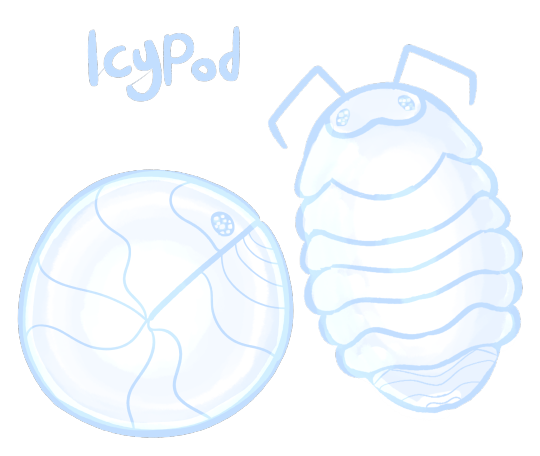
Icypods are a common, harmless Creature found in tundras, glaciers, and mountain peaks. To defend themselves from predators, they curl up into a defensive ball - a behavior known as conglobating. The texture of their carapace is uniquely capable of collecting layers of ice, so when curled, they appear as an inanimate lump of snow.
Icypods are typically harmless to humans, but they can sometimes pose a minor threat to mountainous communities. Under the right conditions, they can curl up into a snowball and roll down a slope, accumulating more and more mass. When they get big and fast enough, they've been known to take out small trees and fences before being stopped by a boulder or an unfortunate mountain cabin. The icypod always emerges unscathed, if disoriented.
They're about 9 inches long, with a diameter of just about 3 inches when conglobated - about the size of a baseball. Icypods are larger than any currently known terrestrial isopods, leading some Enthusiasts to theorize that they may have a bit of deep-sea dwelling Giant Isopod in them, but modern DNA analysis techniques suggest they were formed from your regular backyard roly-poly, Armadillidium vulgare.

Podsicles are a larger variant of Icypod, formed when an adult Icypod is exposed to subzero temperatures for extended periods of time. Their carapace begins to form dense icicle-like structures, making them even more unpalatable to most predators. Podsicles have much more control over their snowball avalanche, deliberately rolling down ramps to fling themselves at high speeds to injure potential aggressors.
9 notes
·
View notes
Text
Hybrids In Chima
Hybrids in Chima have a lot of problems to contend with: being outcasts by social conventions, complicated medical histories and conditions, and potentially even exile for the smallest of “crimes” if tried by the Lion elder council. Despite that, some have carved their niches into Chiman history in various ways.
Grainne the Griffin
Time Period: early Chima
Parentage: Eagle mother, Lion father
Pronouns: she/her (intersexed according to legend)
Sexuality: unknown
Appearance: (according to legend) brown feathers and fur, yellow bird eyes, taloned feet, feathered wings
History: Grainne was abandoned by both the Eagle and Lion Tribes upon discovery of her birth. She was practically raised by Chima itself, growing up in the wilds between the Tribes. When she became an adult, she discovered an Eagle man whose name has been lost to time, and the two became friends. He betrayed her, leaving her for dead, and her last words were a promise that he would pay for his betrayal. He died shortly after.
Legacy: Grainne has been remembered in a constellation named for her, made of seven stars that are too dim to see any time other than during the winter solstice. In the afterlife realm (the Bear Dream Realm), she has become friends with King Lupercalia and his partners as well as Queen Liberta, and she spends a lot of her afterlife starting fights for fun.
Reegull the Raven-Eagle
Time Period: modern Chima
Parentage: Eagle father, Raven mother
Pronouns: he/him
Sexuality: wouldn’t you like to know, weather boy?
Appearance: black and white feathers, yellow bird eyes, prosthetic left leg, hook for right hand, mismatched feathered wings, varying other prosthetics
History: Reegull is very good at causing a lot of trouble for everyone. Like some hybrids, he lashes out at the society that cast him out (even his own parents didn’t want him, which sadly isn’t uncommon among hybrids). He has studied alchemy and botany, among other sciences, and works for whoever he believes he can dupe into furthering his own goals.
Legacy: Reegull is known as both the creator of Chigull (also known as fake Chi) and as a biologist studying the Chi that can be found in plants around Chima (which he was trying to use for his own ends, of course).
Sparrmax the Scorpion
Time Period: modern Chima
Parentage: Scorpion parent, Spider parent (unclear who was what)
Pronouns: he/him (doesn’t understand gender)
Sexuality: questioning (considers himself too young to worry about that)
Appearance: dark blue carapace, gold detailing, light brown eyes, white fangs, tail with stinger, visibly a Scorpion
History: Sparrmax is a Scorpion who also happens to be half-Spider. The Scorpion Tribe doesn’t follow Chima’s example of how to treat hybrids, instead treating Sparrmax as a full Scorpion since he chose them over the Spiders. Unlike other Scorpions, he doesn’t have any venom. He’s got a good eye for things that other Tribes would want, which puts him pretty high in the chain of command when it comes to cross-Tribal diplomacy. General Scolder is considering naming Sparrmax as his Lieutenant, putting him in line to become the General himself when Scolder becomes the Scorpion King.
Legacy: Sparrmax is a beloved member of the Scorpion Tribe and is one of the first hybrids to be fully accepted and integrated into the Tribe, unintentionally paving the way for hybrids of other Tribes to be recognized as Scorpions.
#jasper post#legends of chima#lego legends of chima#lego chima#chima#tales of chima#writing#my writing#worldbuilding#grainne the griffin#reegull#loc reegull#sparrmax#loc sparrmax
19 notes
·
View notes
Text
"are chess person carapaces rigid or supple" when the comic literally uses both words is such a classic bit of Homestuck wank. what is even the modern day version of that. i don't think there is one
9 notes
·
View notes